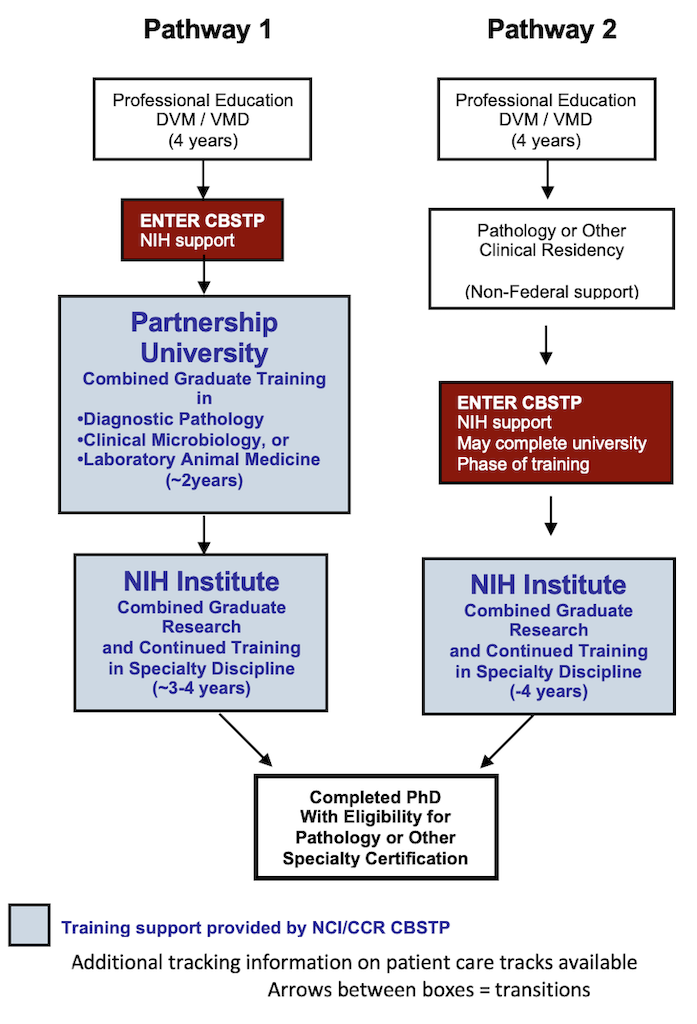NIH Comparative Biomedical Scientist Training Program (CBSTP) COMBINED PATHOLOGY, or OTHER CLINICAL SPECIALTY, & RESEARCH TRAINING
This program is tailored for those with doctoral degrees in veterinary medicine, who intend to seek advanced training through our legacy program in veterinary pathology, or now expanded opportunities in a variety of other clinical specialties and research (relevant list below). Our aim is to prepare veterinarians for careers as comprehensively trained clinician-scientist investigators, experimentalists, and scientific research collaborators. This is accomplished by combined training in both clinical veterinary medicine and human biomedical research. This training leads to a Ph.D. and eligibility for certification as a veterinary medical specialist.
Trainees take advantage of the strengths of outstanding university-based clinical and graduate education training at one of our partnership universities and the phenomenal basic, translational and clinical research opportunities at the NIH.
This program allows for integration across classic research disciplines including:
- Allergy
- Autoimmunity
- Blood Disorders
- Carcinogenesis and pre-cancer growth disturbances
- Cell, stem cell and developmental biology
- Disease tissue heterogeneity, microenvironment and host response
- Immunology
- Infectious diseases
- Metastasis
- Molecular and computational pathology
- Neurological disorders
- Pulmonary diseases
- Stroke
- Therapeutics
- Virology
- Vaccine development
- Many others
Research training is combined with participation through specialty clinical training in a variety of veterinary medical disciplines, in addition to our initial program in pathology, that most closely align with our NIH intramural research program sponsors, such as:
- Cardiology
- Clinical Genetics†
- Dermatology (& Allergy/Immunology†)
- Diagnostic Imaging/Radiology/Molecular Imaging
- Infectious diseases†
- Hematology†
- Internal Medicine
- Laboratory Animal Medicine
- Microbiology
- Medical Oncology
- Neurology & Neurosurgery
- Pathology
- Surgery
†Not a specifically recognized veterinary specialty board
Training is offered through a consortium of 5 Universities and 4 NIH Institutes
This program combines the unique training strengths from both leading diagnostic pathology and graduate programs with training at the National Institutes of Health (NIH).
Eligibility
To be eligible for admittance to this program, applicants must have obtained a D.V.M./V.M.D. or equivalent professional degree from a recognized veterinary college and have less than 5 years relevant postdoctoral training experience, and must be US citizens or permanent residents (green card).
How the Program Works
Our trainees generally have two routes of entry into this program. Trainees who hold the D.V.M./V.M.D. degree enter the program at the initiation of specialty training or they are current residents in a recognized post D.V.M./V.M.D. training program. (see diagram below). Individuals completing residency are also eligible to enroll for graduate training.

-
Pathway 1
Trainees enter the combined graduate program upon completion of their D.V.M./V.M.D. The core experience in specialty training chiefly takes place at a partnership university during the first two years of the program, along with the graduate school required didactic course work. Some program tracks may require longer study at the university (detailed further in the university program information). During the university phase, trainees will work with the program to identify an NIH mentor for Ph.D. dissertation research. The determination of mentor is based on agreement between the trainee and the mentor, and must receive approval from the CBSTP program director, the CCR training director, the university mentor and the scientific director of the participating NIH institute.
Trainees then transition to the NIH. Initial experience at NIH may include a laboratory bench experience in basic molecular pathology techniques. This experience can be tailored to the needs of the trainee. Examples of relevant techniques include:
In vivo non-invasive medical imaging, Polymerase chain reaction, Immunohistochemistry, in situ hybridization and digital pathology computational image analysis.
Once the laboratory match has been made, PhD dissertation research begins. Additional training is provided, throughout the course of training from the MPU, and includes: diagnostic slide seminars, work in progress seminars given by trainees conducting dissertation research, pathology, and other investigative techniques training sessions. Example modules may include:
Rodent research necropsy, Rodent pathology and phenotyping, Laser capture microdissection, Digital slide scanning and quantitative morphometric image analysis, as well as others.
Pathway 2
Trainees enter the program following having acquired at least 2 years or more of diagnostic pathology or other clinical training. Unless entering the program while attending a university partner, during the first year within the CBSTP program, trainees will be situated in the MPU while they complete their didactic graduate coursework at the University of Maryland, College Park. Additionally, while in the MPU, trainees will participate in laboratory bench experiences in molecular and computational pathology techniques, and pre-dissertation research. For pathway 2 trainees, this is also the time a dissertation mentor is sought, through the same process described above for pathway 1 trainees.
Additional, similar tracks are being organized for a variety of other clinical disciplines. Time in training will vary, influenced by elements such as
- requirements for completing learner objectives among various disciplines necessary for specialty certification eligibility, and
- progress toward degree and in meeting graduate school requirements, which also vary among partnership institutions.
Comparative Biomedical Scientist Training Program Support
Training support is provided to trainees through a Cancer Research Training Award (CRTA) (or Intramural Research Training Award IRTA) appointment, funded through the NIH Intramural Research Program. Funding is provided for 5 to 7 years; up to 2 years at a partnership university, and for 3-4+ years at the NIH for Ph.D. dissertation research. Depending on individual university program tracks, some funding may be provided by partnership universities.
Training support includes an attractive post-doctoral stipend, health insurance, university tuition, books, travel (to scientific meetings, and to university committee meetings), research project resources, and an allowance for relocation from the partnership university to the NIH, while in training.

